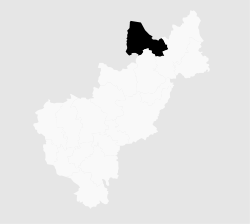Arroyo Seco (Querétaro)
| Arroyo Seco | |
|---|---|
| Town | |

Plaza and main church in municipal seat
|
|
 Location of municipality in Querétaro |
|
| Location in Mexico | |
| Coordinates: 21°32′50″N 99°41′18″W / 21.54722°N 99.68833°WCoordinates: 21°32′50″N 99°41′18″W / 21.54722°N 99.68833°W | |
| Country |
|
| State | Querétaro |
| Founded | 1833 |
| Municipal Status | 1933 |
| Government | |
| Area | |
| • Total | 731.1665 km2 (282.3050 sq mi) |
| Elevation (of seat) | 960 m (3,150 ft) |
| Population (2005) Municipality | |
| • Total | 12,493 |
| • Seat | 1,303 |
| Time zone | CST (UTC-6) |
| Postal code (of seat) | 76440 |
| Website |
www |
Arroyo Seco is a town in Arroyo Seco Municipality located in the far north of the Mexican state of Querétaro. Its territory is part of the Sierra Gorda Biosphere Reserve of Querétaro. The municipality is centered on the small town of Arroyo Seco, which was established as a military outpost then given town status in 1833 under the name of Villa de Guadalupe before changing to its current name. The town gained municipal status in 1931. The area is very rural with most people living in communities of under 100 people, with significant Pame communities. It has a traditional economy based on agriculture, livestock and forestry but it is also one of the poorest in Mexico, with high rates of emigration, especially sending migrant workers to the United States. It is estimated that one in four households in the municipality receives money from family members in this country. The municipality is also home to one of five Franciscan mission complexes built under the tenure of Junípero Serra, located in the community of Concá.
Arroyo Seco is a small town of about three hundred homes centered on a plaza named after Mariano Escobedo. The town originated as a military outpost called the Presido de Arroyo Seco. It became the seat of the municipality of the same name in 1931.
The houses are painted in various colors and its streets are quiet. The town is home to all municipal services and has the most developed infrastructure and social services in the area. This includes the Casa de Cultura cultural center, an auditorium and a library. The Mariano Escobedo plaza has an “oriental” style kiosk surrounded by large trees. On one side the main parish church called the Nuestra Señora de Guadalupe dominates. This church was begun in 1904 and was supposed to be much larger than it is, but construction was suspended due to the Mexican Revolution. It has an austere facade and the interior has black pews. The most important yearly event in the municipal seat is the feast of the Virgin of Guadalupe on 12 December.
Handcrafts such as saddles, leather goods and wooden barrels for water storage can be found in the town.
...
Wikipedia

